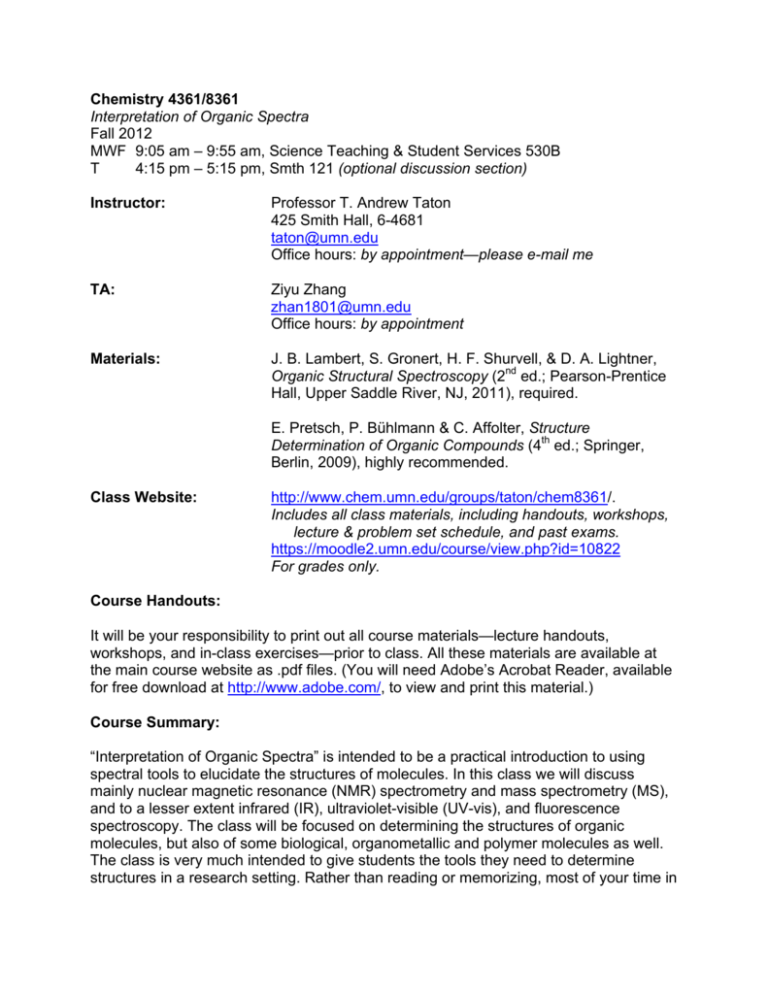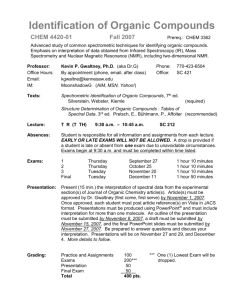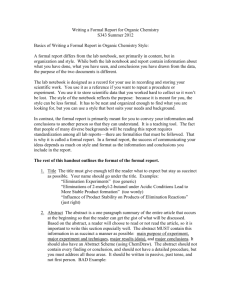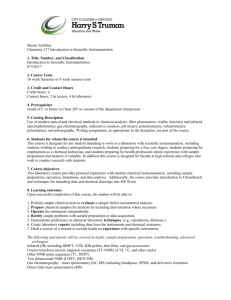
Chemistry 4361/8361
Interpretation of Organic Spectra
Fall 2012
MWF 9:05 am – 9:55 am, Science Teaching & Student Services 530B
T
4:15 pm – 5:15 pm, Smth 121 (optional discussion section)
Instructor:
Professor T. Andrew Taton
425 Smith Hall, 6-4681
taton@umn.edu
Office hours: by appointment—please e-mail me
TA:
Ziyu Zhang
zhan1801@umn.edu
Office hours: by appointment
Materials:
J. B. Lambert, S. Gronert, H. F. Shurvell, & D. A. Lightner,
Organic Structural Spectroscopy (2nd ed.; Pearson-Prentice
Hall, Upper Saddle River, NJ, 2011), required.
E. Pretsch, P. Bühlmann & C. Affolter, Structure
Determination of Organic Compounds (4th ed.; Springer,
Berlin, 2009), highly recommended.
Class Website:
http://www.chem.umn.edu/groups/taton/chem8361/.
Includes all class materials, including handouts, workshops,
lecture & problem set schedule, and past exams.
https://moodle2.umn.edu/course/view.php?id=10822
For grades only.
Course Handouts:
It will be your responsibility to print out all course materials—lecture handouts,
workshops, and in-class exercises—prior to class. All these materials are available at
the main course website as .pdf files. (You will need Adobe’s Acrobat Reader, available
for free download at http://www.adobe.com/, to view and print this material.)
Course Summary:
“Interpretation of Organic Spectra” is intended to be a practical introduction to using
spectral tools to elucidate the structures of molecules. In this class we will discuss
mainly nuclear magnetic resonance (NMR) spectrometry and mass spectrometry (MS),
and to a lesser extent infrared (IR), ultraviolet-visible (UV-vis), and fluorescence
spectroscopy. The class will be focused on determining the structures of organic
molecules, but also of some biological, organometallic and polymer molecules as well.
The class is very much intended to give students the tools they need to determine
structures in a research setting. Rather than reading or memorizing, most of your time in
this course will be spent solving spectral problems; many of these problems come from
current research at the University of Minnesota. If you are not presently doing research
involving molecules, or you don’t see yourself solving molecular structures for a living in
the near future, you will probably not get very much out of this class. On the other hand,
if you do or plan to do research involving organic molecules, this class will be extremely
useful for you.
Reserve Materials:
(All available through Walter Library Reserve unless noted.)
J. B. Lambert, S. Gronert, H. F. Shurvell, & D. A. Lightner, Organic Structural
Spectroscopy (2nd ed.; Pearson-Prentice Hall, Upper Saddle River, NJ, 2011).
Course text.
P. Crews, J. Rodriguez, M. Jaspars, Organic Structure Analysis (2nd ed.; Oxford
University Press, New York, 2009). A similar text to Lambert. Another good
source of problems to solve.
E. Pretsch, P. Bühlmann & M. Badertscher, Structure Determination of Organic
Compounds (Springer, Berlin, 2009 [4th ed.]; 2000 [3rd ed.]). Highly
recommended course material; contains useful tables for spectral structure
determination. 3rd ed. is in Walter Reference Library, 2nd floor; also available
as an electronic reference at http://www.springerlink.com/content/r2628g/.
E. Breitmaier, Structure Elucidation by NMR in Organic Chemistry: A Practical
Guide (Wiley, New York, 2002). Great source of complex NMR problems, with
answers.
T. D. W. Claridge, High-Resolution NMR Techniques in Organic Chemistry (2nd
ed.; Pergamon, New York, 2009). Detailed text on NMR methods. Has a
better description of advanced NMR experiments than Crews or Lambert.
Available online at http://tinyurl.com/2wm258f.
S. A. Richards, J. Hollerton, Essential Practical NMR for Organic Chemistry (Wiley,
New York, 2011). Clear set of practical tips on how to take a good NMR
spectrum. Available online at http://tinyurl.com/44d5crs.
E. de Hoffmann, V. Stroobant, Mass Spectrometry: Principles and Applications (3rd
ed.; Wiley, New York, 2007). Excellent text on methods and interpretation in
mass spectrometry.
F. W. McLafferty, F. Tureček, Interpretation of Mass Spectra (University Science
Books, Mill Valley, CA, 1993). Classic text on ion abundance and radical
fragmentation in mass spectrometry. However, the book has not been
updated in quite a while, and doesn’t have as much information about modern
MS methods.
Grading:
5361 (3 cr): 60% Midterms (4)
30% Final
10% Problem sets
8361 (4 cr): 45% Midterms (4)
22.5% Final
7.5% Problem sets
25% Labs
The four midterms will be counted equally as 100 points each, and the final will be worth
200 points. Exams will be open book and open note; you may bring any materials you
see fit to exams. However, student cooperation (including sharing materials or notes) on
exams is prohibited. You may be excused from taking an exam due to jury duty,
subpoenas, military service, religious holidays, and participation in school sports events
only if the instructor is notified two weeks in advance. You may also be excused in case
of illness (as verified by a doctor's note) or death in the immediate family (be prepared
to verify) if the instructor is notified within 24 hours after the exam.
Exams will be returned to you in class, as soon as we can grade them. If you feel that
your exam has been incorrectly graded—that is, if the exam rubric has been incorrectly
applied to your exam—I encourage you to request that your exam be re-graded. Please
submit your request for an exam re-grade to me in the class period immediately after
the one in which the exam is returned to you. Requests should be written on a separate
piece of paper from the exam (please do not write on the exam), attached to the exam,
and should explain how the exam rubric was incorrectly applied to your exam. If you feel
the rubric was correctly applied as written, but you don’t agree with the rubric, you are
also welcome to submit a comment to me and I will consider it, but be warned that in
many cases we may have to agree to disagree. (Of course if I have made a mistake in
designing the rubric I will correct it!)
Problem sets will be posted to the web; see the online course schedule for due dates.
Answer keys will be available on the web on the due date, and the problem sets can be
discussed in the following discussion section. Because the answer keys will be available
immediately after the problem sets are due, sets cannot be turned in late. Problem sets
will be graded on effort rather than correctness, and intelligent attempts to answer all
problems will receive full credit. Working together on problems is highly encouraged, but
you should submit your own solutions. We will also be conducting periodic problem
solving workshops throughout the semester; these will not be graded, and are primarily
to help you with problem solving skills.
Labs will be conducted in the Chemistry Department NMR Facility and Mass
Spectrometry Facility. Labs are required for all students enrolled in Chem 8361.
Instructions for writing up each lab are in the lab instructions. Total credit for all lab
writeups will sum to 200 points. Labs may be turned in late, at a penalty of 20 points per
week (rounded up—one day = one week).
All students and instructors should be reachable at their University-wide e-mail
accounts. If you normally use a departmental or private e-mail account, you should set
up your University-wide account to automatically forward messages to this other
address. You can do this most easily through the account settings page,
http://www.umn.edu/validate.
Academic integrity is essential to a positive teaching and learning environment. All
students enrolled in University courses are expected to complete coursework
responsibilities with fairness and honesty. Failure to do so by seeking unfair advantage
over others or misrepresenting someone else’s work as your own can result in
disciplinary action. More information on the definition and consequences of academic
dishonesty can be found at the Office for Student Academic Integrity website
(http://www.osai.umn.edu/). In this course, direct copying of homework assignments or
lab reports, or any cooperation on exams, will be considered dishonest. Any student
responsible for scholastic dishonesty can be assigned a penalty up to and including an
"F" or "N" for the course. If you have any questions regarding the expectations for a
specific assignment or exam, please ask.
Our goal is to be as available and as accommodating as we can be. If you feel you are
having troubles or concerns about the class, please feel free to contact Andy or Ziyu. If
you feel for any reason that we are not taking your concerns seriously, and that this is
negatively impacting your learning, the Student Dispute Resolution Center
(http://www.tc.umn.edu/~sos/) makes both informal (ombudsman) and formal (advocate)
representatives within the University available for students to share their concerns with.






